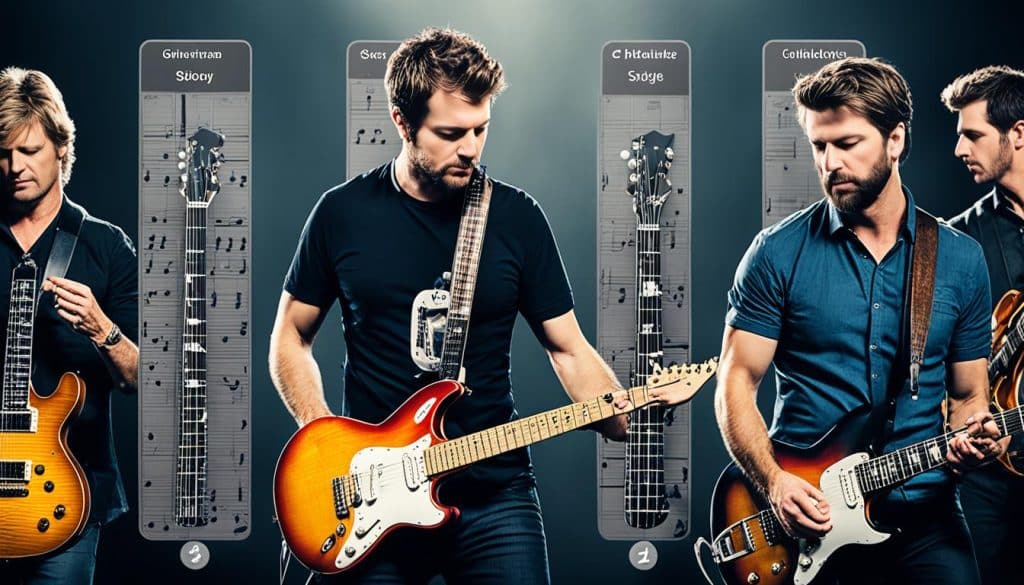Did you know that starting with E minor pentatonic and A minor pentatonic scales is great for beginners? These scales not only help in building finger strength but also make you familiar with the fretboard1. By practicing these, you lay a strong foundation for improvisation and learning advanced techniques2. The minor pentatonic scale, for instance, is very flexible. It fits well in blues, rock, and metal because it omits certain notes2. Fretboard diagrams are also crucial. They show you where to place your fingers, speeding up your learning process1.
Key Takeaways
- Beginner guitarists should start with the E minor pentatonic and A minor pentatonic scales1.
- Practicing guitar scales regularly is essential for developing finger strength and dexterity1.
- Fretboard diagrams can help you visualize finger placement efficiently1.
- The minor pentatonic scale is key to playing blues, rock, and metal2.
- Learning guitar scales improves your improvisation and overall playing abilities2.
For more tips on mastering guitar scales, check out this complete guide. Visit Cryptsy for more resources and expert advice!
Understanding Guitar Scales: A Comprehensive Guide
Guitar scales are sequences of notes for playing melodies. These scales are crucial in exploring music. Knowing how to practice scales well improves your guitar skills.
The C major scale includes notes C, D, E, F, G, A, B, C3. The E minor pentatonic scale has E, G, A, B, D, E3. These patterns help you understand the guitar fretboard better.
Learning scales means knowing note intervals, like semitones and tones. A semitone is one fret; a tone is two4. Starting with one string helps grasp these intervals quickly4.
Visual tools, such as scale diagrams, are handy in practice. They show strings and frets4. These diagrams let you move scales to different fretboard spots4. This makes integrating scales into playing easier.
| Scale Name | Notes | Intervals |
|---|---|---|
| C Major Scale | C – D – E – F – G – A – B – C | Tone, Tone, Semitone, Tone, Tone, Tone, Semitone |
| E Minor Pentatonic Scale | E – G – A – B – D – E | Tone, Tone, Minor Third, Tone, Minor Third |
| A Minor Pentatonic Scale | A – C – D – E – G – A | Minor Third, Tone, Tone, Minor Third, Tone |
| G Major Scale | G – A – B – C – D – E – F# – G | Tone, Tone, Semitone, Tone, Tone, Tone, Semitone |
| E Harmonic Minor Scale | E – F# – G – A – B – C – D# – E | Tone, Semitone, Tone, Tone, Semitone, Augmented Second, Semitone |
The Importance of Learning Guitar Scales
Learning guitar scales is crucial for improving your playing skills. Mastering scales helps you play more smoothly and accurately. This ability leads to better melodies and improvisation. Neil Young stressed how vital scales are in music. He said they boost not just technique but the quality of music5.
Developing Finger Strength and Dexterity
Practicing scales strengthens your fingers and increases dexterity. It also boosts coordination and playing speed. This is important for many music styles like jazz and rock5. With strong technique, you can easily play complex solos6. Scales also build your ability to play leads6. This makes you a better, more creative guitarist.
Improving Fretboard Familiarity
Learning scales helps you know the fretboard better. It lets you find notes quickly, whether playing solos or chords5. Understanding scales means you can visualize where to place your fingers. This skill helps you play more naturally7. With this knowledge, you can learn music faster and make more complex compositions5.
Building the Foundation for Improvisation
Improvisation is one of the best things about knowing guitar scales. Scales form the basis of melody and harmony7. Practicing them, like in sequences, is great for warm-ups. It sets the groundwork for improvisation and writing music7. Learning scales can improve your songwriting. This makes creating new melodies and improvising easier, especially in jazz and rock5.
Popular Guitar Scales Every Guitarist Should Know
Learning key guitar scales is key to getting better at guitar. It helps you play solos and explore blues music. The Major Scale, Minor Pentatonic Scale, and Blues Scale are very important. They each have their own sound and uses. Knowing these scales makes your music better and helps you grow as a guitarist.
Major Scale
The Major Scale is vital in Western music. It has 8 notes, including the octave. Its pattern is: Root note – whole – whole – half – whole – whole – whole – half8. This scale is the base of music theory. It’s a must for serious guitar players9. Working on this scale helps you know your way around the fretboard and make melodic solos.
Minor Pentatonic Scale
The Minor Pentatonic Scale has 5 notes: A, C, D, E, G8. It’s very flexible and works in most music scenes. That’s why many guitarists love it9. Its simple pattern is great for making solos and improvising, especially in blues. Icons like Stevie Ray Vaughan and Eric Clapton use it for their famous solos.
Blues Scale
The Blues Scale adds a flattened 5th to the Minor Pentatonic Scale, making it sound bluesy8. It has notes: A, C, D, E, G, and B flat. This scale is loved by beginners for its deep, expressive sounds. It’s key for blues music9. Greats like John Mayer and Clapton show how important this scale is for blues guitarists.
Mastering these guitar scales improves your technique and emotional expression in music. It makes your solos stand out and memorable.
How to Practice Guitar Scales Effectively
Mastering guitar scales is key to grow musically and boost your skills. It’s important to practice with a metronome, explore different positions, and do scale exercises regularly. These steps will help you make consistent progress in mastering the guitar.
Using a Metronome
A metronome keeps your rhythm steady and improves your timing. Start slow and speed up as you get comfortable. This boosts your finger speed and prepares you for complex music pieces.
Practicing in Different Positions
Practicing scales in various fretboard positions increases your versatility. Start in one spot, then try others. For instance, mastering scales across three to six frets can sharpen your technique and improvisation10. This method makes your finger movements more accurate, enhancing your overall skill.
Incorporating Scale Exercises into Daily Routine
Make scale practice a daily habit to keep progressing. Aim for at least 10 minutes of scales practice each session10. Begin with simple tasks, like the chromatic scale, then tackle one-octave scales. This improves your rhythm and timing.
Spending 5 to 30 minutes a day on scales is advised, depending on your level and goals11. Change up your exercises to push your limits and prevent getting stuck11. With dedication, you’ll expand your musical range and refine your talents.
Fostering growth with challenging exercises
| Practice Technique | Benefit | Recommended Duration |
|---|---|---|
| Using a Metronome | Improves timing and rhythm | 5-10 minutes |
| Practicing in Different Positions | Enhances versatility and technique | 10 minutes |
| Incorporating Scale Exercises | Builds consistency and skill | 10-20 minutes |
Common Mistakes to Avoid When Practicing Guitar Scales
One common trap beginners fall into is rushing through scales. Doing this can mess up finger placement and slow your growth12. It’s better to aim for being right rather than fast, starting slow at 50% tempo to get the technique right12. Also, it’s vital not to forget about developing musical reflexes while practicing scales13.
Not using a metronome is another big mistake. A metronome keeps your tempo and rhythm steady, which is crucial for smooth playing12. Adding a metronome to your practice can really up your timing and make your music flow better.
Another issue is repeating mistakes over and over. It cements wrong methods and hampers your progress13. Aim to play it right each time to dodge forming bad habits. Pushing the strings too hard is common for starters12. Use just enough pressure and correct finger settings to stay in control and avoid strain.
Skipping a professional guitar setup might be holding you back too. Many guitars need adjusting to play their best, which can speed up your learning12. Getting it set up just for you helps with playability and comfort. Also, practicing with many effects on can hide errors, making it hard to judge your real level12. Try playing with and without effects to get a true sense of your skills.
Finally, not practicing consistently can block your growth. Short, daily sessions are better for nailing down techniques and building muscle memory than occasional long ones12. Sticking to regular practice and focusing on correct finger use is crucial for mastering your instrument over time.
Mastering the Pentatonic Scale for Rock and Blues
The pentatonic scale makes playing rock or blues on the guitar simpler. It has five notes which opens the door to playing both simple and complex pieces. Mastering it lets guitarists improvise and play more flexibly. The major and minor scales are important because they sound different and are versatile.
Major Pentatonic Scale
The major pentatonic scale is popular for its cheerful sound. It’s made of five notes and is used a lot in rock music solos and melodies. This scale helps build the foundation for many famous rock songs. It makes your guitar playing sound joyful.
Practicing this scale helps improve finger strength and movement. It’s good for beginners because it doesn’t have half-steps, making melodies smoother1415.
Minor Pentatonic Scale
The minor pentatonic scale is key in blues music for its deep, expressive sound. It has five notes, including the root and flat third15. This scale is core to playing blues solos that touch the heart. It’s designed for easy play, avoiding half-steps and making smooth transitions possible15.
Learning this scale in all five positions helps you see chord shapes better16. This skill lets you switch between chords smoothly. It’s crucial for playing solos that capture the emotion of blues music.
Exploring Advanced Guitar Scales: Modes and Beyond
Learning advanced guitar scales is a gateway to new music expression for pros. Scales like the Dorian, Mixolydian, and Phrygian modes unlock exotic sounds and complex melodies.
Dorian Mode
The Dorian mode is loved in jazz fusion for its unique sound, thanks to the raised sixth note. It’s a top pick among the six key scales used in advanced guitar playing17. Players can learn it in two main positions, making it easy to pick up17.
Mixolydian Mode
The Mixolydian mode, with its dominant seventh, adds a bluesy feel to your music. It’s among the six must-know scales for guitarists17. Its sound fits well in many genres, helping you blend old and new music styles.
Phrygian Mode
The Phrygian mode stands out for its mysterious vibe, enhancing creativity. It’s great for coming up with new songs18. Learning its scales and formulas is straightforward, helping you master it quickly18.
Adding these modes to your practice boosts your jazz skills and creativity19. They open up new paths in your musical journey. Now, let’s see how these modes compare:
| Mode | Characteristic Note | Common Use |
|---|---|---|
| Dorian | Raised Sixth | Jazz Fusion17 |
| Mixolydian | Dominant Seventh | Blues, Rock17 |
| Phrygian | Flat Second | Adding Exotic Sounds18 |
Essential Guitar Scale Exercises for Beginners
For beginners, learning the basic guitar fundamentals is key. Start with major and minor pentatonic scales. These scales are easy to learn and important for developing your skills and understanding music keys.
Warm-ups are very important. Spend about 10 minutes warming up before you practice your scales20. This prepares you for a productive session. Try patterns like “4 steps forward, 2 steps back” to improve your muscle memory and fingers’ flexibility20.
Practicing with a metronome helps speed, timing, and finger skills20. Creating your own scale exercises is better than just using tabs20. Trying different patterns, like 3-notes-per-string, can make your fingers more agile and skillful20.
A good practice routine includes Scales, Chords, Technique, and Fun Stuff21. Make sure you do 10 clean runs up and down each scale21. Try playing different scale shapes, like A minor or G Major, to keep things interesting21.
Setting a daily practice routine focusing on one exercise a day is a great goal20. This way, you’ll steadily get better. By regularly doing these exercises, you’ll master the basics and enjoy your guitar journey.
Integrating Guitar Scales into Your Solos and Riffs
Getting guitar scales into your solos and riffs takes more than just skill. It also needs you to creatively use scales. By learning different techniques, you can make solos that really pull in the audience. Let’s dive into how to blend scales into your music, making your performances stand out.
Creating Melodic Solos
Making melodic solos is about more than knowing notes. It’s about using scales to express feelings and tell a story. The A minor pentatonic scale is great for this. It works well over G, C, or D chords, including variations like G7, C7, or D7, especially in blues22. Focus on the quality of every note. Use techniques like bending, and keep rhythm and groove in mind to make your solos touching22. Also, linking scale patterns through small steps can spark your creativity, as shown in the guides23.
Improvising with Scales
Improvisation is key for standing out in soloing. Limiting the use of one finger when playing can help. It makes you break old habits and think of new tunes24. Also, try making musical statements with pauses. This makes every note important24. Playing solos on one string can also help. It improves your ear for music, rhythm, and melody, getting you out of usual scale patterns24. These methods show how vital creativity and musical sense are for improvising.
To get better at using scales, create your own licks and solos. Take inspiration from connecting scale patterns and dedicated practice. Playing around with short phrases and focusing on the groove can make your music pop2322. Remember, the way you think during practice can greatly affect how well you learn23. Check out this guide for more tips.
Using Fretboard Diagrams to Learn Guitar Scales
Fretboard diagrams are key for learning guitar. They help show where to put your fingers. These visuals cover both guitar and bass scales25. There are different types, like full fretboard views and note names. This makes them great for musicians at any level25.
Visualizing Finger Placement
With fretboard diagrams, it’s clearer where to place your fingers. Take the E minor pentatonic scale, for example, which has 5 notes: E – G – A – B – D – E3. By using these diagrams, practicing becomes more precise, improving your skill. Viewing scales like the C major scale also helps organize your finger movements3.
Practicing with Scale Charts
Scale charts are very helpful for learning scales. For example, the E harmonic minor scale goes from a low to high E note: E – F# – G – A – B – C – D# – E3. These charts make remembering scale patterns and refining your technique easier. Adding three-octave patterns and variations will enrich your music26.
Regularly using fretboard diagrams helps you know scales like G major scale (G – A – B – C – D – E – F# – G) better3. This not just boosts your fretboard knowledge but also aids in music creation and soloing.
The Role of Muscle Memory in Mastering Guitar Scales
Muscle memory is crucial for mastering guitar scales. It lets you play the guitar effortlessly after dedicated practice27. Procedural memory helps you perform tasks automatically, without needing to think hard about them27. By learning guitar scales, your fingers become more nimble, improving your guitar skills28.
The Fitts’ model explains how we learn these automatic actions. It starts with the cognitive phase, where every movement is thought out27. Then, with practice, these actions become automatic in the associative phase27. Finally, in the autonomous phase, you play scales instinctively, which lets you focus on playing more artistically27.
To play guitar effortlessly, build muscle memory with regular practice. It often takes 20 to 30 days to memorize a chord or scale fully29. With daily training, your fingers will easily move across the fretboard. Guitar scales not only improve finger movement but also boost your ability to improvise28.
Combining muscle memory with guitar practice requires patience and hard work. To fully embed a music piece into your memory, practice it twice daily for 2 to 3 months29. Early on, it’s important to correct mistakes methodically. This ensures you perform well and master the guitar27. Let muscle memory elevate your guitar skills to greater levels.
Choosing the Best Guitar Scales for Your Musical Style
Picking the right scales for your music style is very important. It helps you adapt to different music genres and become better at guitar. Knowing how scales fit into music styles makes you more versatile.

Rock and Metal
The Minor Pentatonic Scale is a must-have for rock and metal players. It uses notes like 1, 2, b3, 4, 5, b7. This scale has an aggressive sound perfect for heavy riffs and solos.
The Major Pentatonic Scale is also great for rock and metal. It keeps the notes 1, 2, 3, 5, 6. It helps your chords and solos sound tough yet melodic30.
Blues and Jazz
In blues and jazz, the Blues Scale is key. It has a unique mix of notes for a soulful sound. Many beginners struggle without it, missing out on its expressive power31.
It’s important to know scales and chords are different. Scales are single notes played in sequence, and chords are notes played together. This is vital for blues and jazz improvisation31.
Classical and Folk
For classical and folk, you need a wide range of scales. Modes from the major scale like Dorian, Mixolydian, and Phrygian enrich your music. They bring variety and depth to your performances.
Understanding which scales fit with different music styles is very helpful. It can take your classical and folk music to new heights31.
| Scale | Recommended Genre | Notes |
|---|---|---|
| Minor Pentatonic Scale | Rock, Metal | 1, 2, b3, 4, 5, b7 |
| Major Pentatonic Scale | Rock, Metal | 1, 2, 3, 5, 6 |
| Blues Scale | Blues, Jazz | 1, b3, 4, b5, 5, b7 |
| Modes (Dorian, Mixolydian, Phrygian) | Classical, Folk | Varies |
Learn more about guitar scales and how they can improve your music. Find detailed insights here31.
A Step-by-Step Guide to Playing the Major Scale
Learning the major scale is key for any guitarist. It helps with playing skills and knowing the fretboard better. Let’s look into the steps and techniques you need.
Finger Placement
Getting your fingers right is the first step. The major scale uses a mix of whole and half steps like this: Whole Whole Half – Whole Whole Whole Half32. You start with your index finger on the scale’s first note. Make sure each note follows this pattern correctly.
Scale Patterns Across the Fretboard
Knowing scale patterns helps you move smoothly on the fretboard. The major scale has seven notes before it starts over32. Recognizing these notes in different places means you can play without stopping. Getting the hang of where to put your fingers for each string helps too33.
| String | Fingering | Note |
|---|---|---|
| 6th (E) | 2nd fret | F# |
| 5th (A) | 2nd fret | B |
| 4th (D) | 1st fret | G |
| 3rd (G) | 0 fret (open) | E |
| 2nd (B) | 0 fret (open) | B |
| 1st (E) | 0 fret (open) | E |
Conclusion
Learning guitar scales is key to getting better in music. This detailed guide starts with simple scales and then goes to more complex ones like the Mixolydian or Phrygian modes. Practicing scales regularly makes your fingers stronger and more agile. It also lays a strong foundation for making up your own music, which is essential for playing the guitar well. Mastering these skills is crucial for becoming excellent at guitar, letting you play many types of music easily.
More than 3 million people have learned to play guitar online with sites like Guitar Tricks34. This shows how important it is to practice in a structured way. The article talks about different scales, such as the C major, A minor, pentatonic, and blues scales. Musicians like Eric Clapton and John Mayer use these scales. Adding these scales to your daily practice will surely improve how you play and create music.
Lastly, to get the most from your practice, mix in the exercises, avoid common mistakes, and use fretboard diagrams. Scales can be shifted on the fretboard, changing their key. This lets you be more creative and spontaneous in your music. Remember, becoming a master at guitar takes time. But with hard work and the right resources, you can achieve your guitar playing goals.






